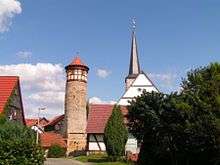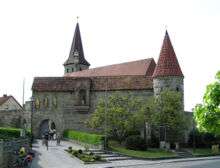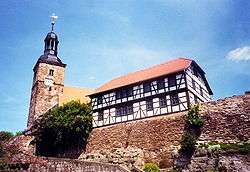Fortress church

A fortress church (German: Kirchenburg) is particular type of church that, in addition to its religious functions is also used by the local population as a retreat and defensive position, similar to a refuge castle. A fortress church usually implies that the church is enclosed by its own fortifications, such as curtain walls and defensive towers. By comparison, a church with simple defensive features, such as battlements and embrasures on the church itself, is usually just referred to as a fortified church.
Architectural history
The fortress church is typically surrounded by defensive walls equipped with wall towers and wall walks. It is a development of the fortified churches, whose defensive walls were also the actual walls of the church. However, the terms are often used interchangeably and there is often no clear distinction. However, generally a fortified church is a single building, whereas a fortress church is a building complex.
In the Early Middle Ages, former bishop's seats, especially in recently Christianised regions like Saxony, were designed as fortress churches. There they were referred to as a Domburg or "cathedral castle".
Fortress churches are especially common in Franconia, South France and Transylvania. Particularly in Transylvania, a historic German settlement area in Romania, there are well over a hundred fortress churches, of which seven have been designated as UNESCO World Heritage Sites (Birthälm/Biertan in 1993, Kelling/Calnic, Wurmloch/Valea Viilor, Dersch/Darjiu, Deutsch-Weißkirch/Viscri, Keisd/Saschiz and Tartlau/Prejmer in 1999). They were built and maintained in order to defend against successive Turkish invasions.
The fortress churches surviving today date from the 15th century. Unlike the populations of towns and cities, villagers did not have the money to build defences around the whole settlement. They were no less vulnerable, however, to the military conflicts of their overlords and the associated raids and plundering. Large bands of marauders were also a danger not to be underestimated. The church was often the only stone building in the village and was, at least, best suited for defence. As a result, the various forms of defensible church appeared, from those surrounded by barns in which a siege of several days could be endured to a fortified cemetery (Wehrfriedhof), to simple fortified churches and, finally, the fortress church.
Fortress churches have not survived in North Germany. This is probably because the stone curtain walls were later dismantled in this area, in which there is a scarcity of stone, in order to be re-used for other purposes. The only well-known fortress church in the coastal region is the Church of St. Dionysius in Bremerhaven-Wulsdorf, which is recorded as having a field stone curtain wall up to 3.60 metres high.
List of places with surviving fortress churches
Austria
Germany

Baden-Württemberg
- Laichingen
- Lienzingen
- Merklingen (Weil der Stadt)
- Sülzbach
- Weissach
Bavaria
County of Kulmbach
County of Eichstätt:
County of Bad Kissingen:
Landkreis Cham
County of Erlangen-Höchstadt
County of Forchheim:
County of Haßberge:
County of Kitzingen:
- Abtswind
- Eichfeld
- Hüttenheim
- Iffigheim
- Kleinlangheim fortress church
- Krautheim
- Markt Einersheim
- Markt Herrnsheim
- Marktsteft
- Iphofen - (Mönchsondheim fortress church museum)
- Nenzenheim
- Segnitz
- Stadelschwarzach
- Tiefenstockheim
- Wiesenbronn
- Willanzheim

County of Main-Spessart:
- Aschfeld (newe der kirch)
- Stetten
County of Miltenberg:
County of Neustadt/Aisch – Bad Windsheim:
County of Rhön-Grabfeld:
- Bad Königshofen im Grabfeld-Althausen
- Heustreu
- Hollstadt
- Mittelstreu
- Nordheim vor der Rhön
- Oberstreu
- Kirchenburg Ostheim
- Serrfeld
- Stockheim
- Unsleben
- Wülfershausen
County of Schweinfurt:
- Donnersdorf
- Euerbach
- Geldersheim
- Gochsheim
- Schleerieth
- Schnackenwerth
- Schwanfeld
- Zeilitzheim
County of Würzburg:
County of Passau:
City of Nuremberg:
- Kraftshof
Lower Saxony
County of Osnabrück:
Thuringia

County of Hildburghausen:
- Ummerstadt
- Streufdorf
- Gellershausen
- Hellingen
County of Schmalkalden Meiningen:
- Rohr (Thuringia)
- Walldorf fortress church
- Vachdorf
Saxony
County of Görlitz
Luxembourg
- Echternach: the former parish church of St. Peter and Paul was built inside Roman walls that protected it until the 18th century.
- Luxembourg city: there is still a tower of the otherwise totally destroyed fortified monastery of Altmünster[1]
- Former parish church of St. Peter and Paul, Echternach
- Tower of the old Altmünster Abbey, Luxembourg
Philippines
- San Ignacio de Loyola Parish Church, Northern Samar
Serbia
Switzerland
- Müstair/GR: Abbey and UNESCO World Heritage Site
- Muttenz/BL: Village church of St. Arbogast – a complete, Late Medieval fortress church
- Sion/VS: Valère Basilica
Romania (Transylvania)

Among the dozens of well-preserved fortified churches in Transylvania (present day Romania), seven of them are located in the UNESCO World Heritage Site inscribed in 1993 as the villages with fortified churches in Transylvania.[2]
See also
References
- ↑ Albert Jacquemin, Burgbefestigungen der Stadt Luxemburg, Imprimerie Saint-Paul, Luxembourg, 1991,163-164
- ↑ Villages with Fortified Churches in Transylvania. UNESCO World Heritage Centre 1992-2010
External links
| Wikimedia Commons has media related to Fortified churches. |
- Fortress churches and Saxon villages (Engl.)
- Photo documentation of German fortress churches in HeidICON (photo data bank of the University Library of Heidelberg)
- History of churches in Transylvania
- Fortress Church Control Centre
- Project for the preservation of fortress churches in Transylvania
- What is a fortress church
Literature
- Karl Kolb: Wehrkirchen in Europa: eine Bild-Dokumentation. Echter, Würzburg, 1983, ISBN 3-429-00818-2
- Wolfram Freiherr von Erfa: Wehrkirchen in Oberfranken. Kulmbach, 1956
- Dirk Höhne: Bemerkungen zur sogenannten Wehrhaftigkeit mittelalterlicher Landkirchen. In: Burgen und Schlösser in Sachsen-Anhalt 12 (2003), pp. 119-149 - kritisch u.a. zu H. Müller
- Dirk Höhne/Christine Kratzke (eds.): Die mittelalterliche Dorfkirche in den Neuen Bundesländern II. Funktion, Form, Bedeutung (= Hallesche Beiträge zur Kunstgeschichte 8), Halle, 2006 (elf Aufsätze zum Thema "Wehrhaftigkeit von Dorfkirchen").
- Norbert Klaus Fuchs: Das Heldburger Land–ein historischer Reiseführer; Verlag Rockstuhl, Bad Langensalza, 2013, ISBN 978-3-86777-349-2
- Hans u. Berta Luschin: Kärntens schönste Wehrkirchen. Carinthia, Klagenfurt, 1985, ISBN 3-85378-237-X
- Karl Kolb: Wehrkirchen und Kirchenburgen in Franken. 2nd edition. Echter, Würzburg, 1981, ISBN 3-921056-16-0.
- Heinz Müller: Wehrhafte Kirchen in Sachsen und Thüringen. Oberlausitzer Verlag, Waltersdorf, 1992, ISBN 3-928492-26-8
- Ursula Pfistermeister: Wehrhaftes Franken : Burgen, Kirchenburgen, Stadtmauern. Carl, Nuremberg, 2000, ISBN 3-418-00387-7
- Gerhard Seib: Wehrhafte Kirchen in Nordhessen. In: Beiträge zur hessischen Geschichte 14. Trautvetter & Fischer, Marburg an der Lahn, 1999. ISBN 3-87822-111-8
- Reinhard Schmitt: „Wehrhafte Kirchen" und der „befestigte Kirchhof“ von Walldorf, Kreis Schmalkalden-Meiningen. In: Burgen und Schlösser in Sachsen-Anhalt 9 2000, pp. 127-149 - kritisch u.a. zu G. Seib
- Michael Weithmann: Wehrkirchen in Oberbayern. Eine typologische Übersicht, in: Schönere Heimat ISSN 0177-4492. 1992, Issue 4, pp. 211-222.
- Joachim Zeune: Neue Forschungen an fränkischen Kirchenburgen. In: Burgenforschung aus Sachsen 5/6 1995, pp. 226-239 - kritisch hierzu, insbesondere zu den Publikationen von Kolb
- Hermann und Alida Fabini: Kirchenburgen in Siebenbürgen : Abbild und Selbstdarstellung siebenbürgisch-sächsischer Dorfgemeinschaften 2nd edn. Koehler und Amelang, Leipzig, 1991, ISBN 3-7338-0073-7
- Hermann Fabini: Atlas der siebenbürgisch-sächsischen Kirchenburgen und Dorfkirchen. Monumenta-Verlag, Hermannstadt, ISBN 3-929848-15-5; AKSL, Heidelberg 1999, ISBN 973-98825-0-1. – 527 fortress churches, all well known, are represented with floor plans and descriptions of their architectural history
- Heinrich Lamping: Kirchenburgen in Siebenbürgen. Geographische Analysen, Kurzbeschreibungen, Bilddokumentation. In: Frankfurter wirtschafts- und sozialgeographische Schriften 57. Selbstverlag des Instituts für Wirtschafts- und Sozialgeographie, Johann Wolfgang Goethe-Universität, Frankfurt, 1991.
- Arne Franke: Das wehrhafte Sachsenland. Kirchenburgen im südlichen Siebenbürgen. Deutsches Kulturforum östliches Europa, Potsdam, 2007, ISBN 3-936168-27-X; Kurzbeschreibung Das wehrhafte Sachsenland. Available online

